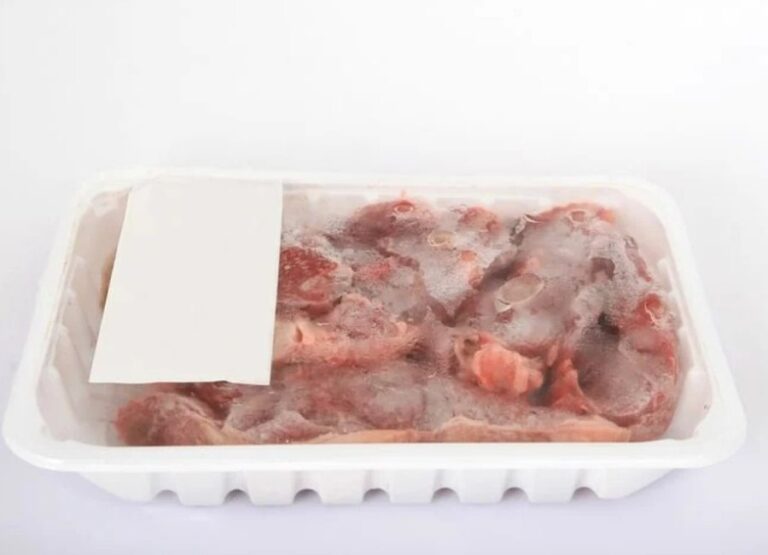How Do You Know When Ground Beef Is Bad [10 Tips]
In this blog post, we’ll discuss how to tell if your ground beef has gone bad and what to do with it.
Have you ever opened your fridge to find a pack of ground beef sitting there for a while?
You’re not sure if it’s still good or if it’s gone bad? Don’t worry, we’ve all been there.
So, let’s get started!
How Do You Know When Ground Beef Is Bad
There are several ways to tell if ground beef is bad.
You can touch it to see if it’s slimy, check the expiration date, examine the texture to see if it’s firm or crumbly, and smell it to see if it has a rancid or sour odor.
If you’re unsure whether ground beef is safe to eat, it’s best to throw it out to avoid the risk of food poisoning.
Common Signs Of A Bad Ground Beef
The following are some common signs of bad ground beef:
1. Discoloration
Instead of the usual pinkish-red color, poor ground beef may be brownish or grayish in color.
The meat’s oxidation, which happens when it is exposed to air for too long, is the cause of this discoloration.
There could be some areas that are still pink because the color change is not uniform.
Before buying or cooking ground beef, you should always check its color.
2. Bubbles or Inflated Packaging
As a consequence of bacteria growing on ground beef, a gas is produced which indicates spoilage.
This gas has the potential to expand or create noticeable bubbles in the container.
This is a blatant sign that the meat is no longer fit for consumption, therefore you should throw it away right away.
3. Foul Odor
A pungent, foul smell that is difficult to ignore is released by ground beef that has begun to rot.
Typically, the smell is described as being sour, putrid, or rotten.
This is due to the bacteria that causes spoiling producing the specific odor-producing chemicals.
As the meat doesn’t smell when it’s fresh, any odor should be a sign that it’s beginning to spoil.
4. Slimy Texture
A bacterial accumulation in spoiled ground beef can make it feel slimy or sticky to the touch.
The meat may feel slimy or slick due to the bacteria’s production of a sticky film on its surface.
Meat with a slimy texture is never a good idea because it can make you sick.
5. Excessive Moisture
Ground beef that has been spoiled may have too much moisture or liquid.
There may be liquid collecting inside the package, and it may feel damp to the touch.
This happens as a result of the bacteria dissolving the flesh and releasing fluids.
Moreover, the moisture may cause the package to seem bloated or inflated.
6. Mold or Fungi growth
In spoiled ground beef, especially if it has been exposed to air for a long time, mold or fungi can grow.
On the surface of the flesh, these growths may appear as green, white, or black spots or patches.
Meat that contains mold or fungal growth should never be consumed because it might have a major negative impact on your health.
7. Patches of Green
In ground beef, green spots or patches indicate the presence of bacteria or mold.
These growths may be brought on by inadequate storage or moisture exposure.
The meat is unfit for consumption because of the substantial amount of bacterial development and the flesh’s green color.
8. Sour Taste
The taste of spoiled ground beef may be acidic or metallic, which is unappealing.
The bacterial decomposition of the meat results in acids that change the flavor of the beef, giving it a sour taste.
It’s recommended to throw out ground beef right away if you detect a sour flavor in it.
9. Unusual Sensations After Consuming
Vomiting, diarrhea, stomach pains, and fever are just a few of the symptoms that might result from consuming rotten ground beef.
Depending on how severe the contamination was, these symptoms may appear shortly after consumption or up to several days later.
After consuming ground beef, it’s critical to get medical help right away if you have any of these symptoms.
Also, you should refrain from consuming ground beef from the same container or supplier in the future.
10. Expiration Date
Checking the expiration date on the packaging of ground beef is vital before purchasing or consuming it because the product has a finite shelf life.
The meat should be eaten or frozen by the date listed on the expiration date.
The meat should be thrown away once the expiration date has passed to reduce the danger of food illness.
Factors That Affect Ground Beef Shelf Life
Here are some common factors that affect the shelf life of ground beef:
- Temperature: Ground beef should be kept at or below 40°F (4°C) to minimize the growth of harmful bacteria.
- Oxygen exposure: Exposure to oxygen can cause a good ground beef to turn brown, which may not necessarily indicate spoilage, but it can affect its flavor and texture.
- Microbial contamination: Ground beef can be contaminated with harmful bacteria such as Escherichia coli (E. coli), Salmonella, and Listeria, which can cause foodborne illness.
- pH level: Ground beef with a higher pH level (less acidic) is more susceptible to bacterial growth and spoilage.
- Moisture content: Moisture content can affect the texture and quality of ground beef, as well as the growth of bacteria.
- Packaging: Vacuum packaging can help extend the shelf life of ground beef, but oxygen exposure can still occur through small leaks or punctures in the packaging.
- Handling and storage: Proper handling and storage practices can help reduce the risk of contamination and spoilage, such as separating raw ground beef from ready-to-eat foods and using refrigeration or freezing.
- Quality grading: The quality of the beef, such as its tenderness, juiciness, and flavor, can affect its shelf life and overall palatability.
It’s important to keep in mind that ground beef can be potentially dangerous if not handled and stored safely.
So, it’s always best to follow safe food handling practices and use or cook ground beef before its expiration date.
Ground Beef Safe Handling Tips to Avoid Spoilage
Here are some tips and general advice on how to safely handle and store ground beef:
- Store raw ground beef in sealed containers or packages so that the juices don’t leak onto other foods.
- Use one cutting board or plate for raw ground beef and another one for ready-to-eat foods like vegetables to avoid cross-contamination.
- Thaw frozen ground beef in the refrigerator or microwave, not on the counter.
- Cook ground beef to an internal temperature of 160°F (71°C) to kill any bacteria or pathogens.
- Refrigerate or freeze ground beef promptly after purchase or use.
- Avoid buying ground beef that looks brown or discolored, which could be a sign of spoilage.
- Check the sell-by or expiration date on the ground beef packaging and use it before the date expires.
- Wash your hands, utensils, and surfaces thoroughly after handling raw ground beef to prevent the spread of bacteria.
- Use safe food handling methods and keep your kitchen clean to reduce the risk of food poisoning.
Following these guidelines can help you prevent foodborne illnesses caused by improper handling or storage of ground beef.
How to dispose of a spoiled ground beef
To safely dispose of spoiled ground beef, wrap it in multiple layers of plastic and place it in a heavy-duty garbage bag.
Double bag the meat if possible and use dark-colored, thicker garbage bags.
Dispose of the bag in a regular trash container or bury it in a nearby landfill.
Keep the garbage can in an area where animals cannot access it until your garbage pick-up day.
If there are bad odors, you can use various items such as coffee grounds, baking soda, vinegar, vanilla extract, charcoal, oatmeal, or lemon slices to help eliminate the smell.
Learn more about how long cooked ground beef can sit out.
Frequently Asked Questions
What are the signs that ground beef has gone bad?
Ground beef that has gone bad may have a sour or ammonia-like smell, a slimy texture, or a grayish-brown color. If you see any of these signs, it’s best to discard the meat.
Can you still cook ground beef if it smells bad?
No, if the ground beef has an off smell, it’s best to avoid cooking it because it may be spoiled or contaminated with harmful bacteria.
Can you freeze ground beef to extend its shelf life?
Yes, you can freeze ground beef to extend its shelf life. Make sure to keep it in an airtight container or freezer bag and use it within 3–4 months for the best quality.
What is the safe temperature to cook ground beef?
The safe temperature to cook ground beef is 160 °F (71 °C) to kill any harmful bacteria that may be present.
You can use a food thermometer to check the internal temperature.
Can you rely on the expiration date to determine if ground beef is still good?
No, it’s important to use your senses to determine if the ground beef is still good.
While the expiration date is a guide, the meat can spoil before that date.
How long can ground beef last in the refrigerator?
Ground beef can last for up to 2 days in the refrigerator if it’s been cooked, or up to 3–4 days if it’s raw.
It’s important to refrigerate the meat promptly to slow bacterial growth.
Conclusion
In conclusion, it’s important to know when ground beef is bad to avoid any potential health risks.
Always check the expiration date and the color and smell of the meat before cooking.
If you’re unsure, it’s better to be safe than sorry and throw it out.
Remember, your health is important, and taking the time to handle and cook your food properly can make all the difference.


![Do You Flip Meat When Smoking [Answered]](https://foodcreeks.com/wp-content/uploads/2023/02/Do-You-Flip-Meat-When-Smoking-768x555.jpg)




